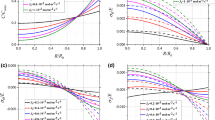Abstract
Nanowire silicon electrodes have an essential potential application in next-generation lithium-ion battery. It is of significance for the development and application of nanowire silicon electrodes to explore the state of charging (SOC) and evaluate the influencing factors. In recent years, many studies show that the lithiation process in silicon electrodes is a two-phase lithiation process, which depends on the rate of interface reaction. In this paper, the effect of interface reaction rate on SOC is studied based on the buckling analysis of a nanowire silicon electrode using a reaction–diffusion model. Temporal evolution of the resultant axial force and the critical force for the buckling of electrode during lithiation, was illustrated and discussed. The analysis of stress was carried out in terms of the theories of finite deformation as well as small deformation. Results show the interface reaction rate has an obvious influence on SOC. Generally, SOC decreases with the increase of the interface reaction rate, but the SOC obtained by a finite reaction rate is always higher than that obtained by the conventional diffusion model.










Similar content being viewed by others
References
Boukamp BA (1981) All-solid lithium electrodes with mixed-conductor matrix. J Electrochem Soc 128(4):725. https://doi.org/10.1149/1.2127495
Baggetto L, Niessen RAH, Roozeboom F, Notten PHL (2008) High energy density all-solid-state batteries: a challenging concept towards 3D integration. Adv Funct Mater 18(7):1057–1066. https://doi.org/10.1002/adfm.200701245
Key B, Bhattacharyya R, Morcrette M, Seznéc V, Tarascon J-M, Grey CP (2009) Real-yime NMR investigations of structural changes in silicon electrodes for lithium-ion batteries. JACS 131(26):9239–9249. https://doi.org/10.1021/ja8086278
Bhandakkar TK, Johnson HT (2012) Diffusion induced stresses in buckling battery electrodes. J Mech Phys Solids 60(6):1103–1121. https://doi.org/10.1016/j.jmps.2012.02.012
Chan CK, Peng H, Liu G, McIlwrath K, Zhang XF, Huggins RA, Cui Y (2008) High-performance lithium battery anodes using silicon nanowires. Nat Nanotechnol 3(1):31–35. https://doi.org/10.1038/nnano.2007.411
Zhang K, Li Y, Zheng B, Wu G, Wu J, Yang F (2017) Large deformation analysis of diffusion-induced buckling of nanowires in lithium-ion batteries. Int J Solids Struct 108:230–243. https://doi.org/10.1016/j.ijsolstr.2016.12.020
Chakraborty J, Please CP, Goriely A, Chapman SJ (2015) Combining mechanical and chemical effects in the deformation and failure of a cylindrical electrode particle in a Li-ion battery. Int J Solids Struct 54:66–81. https://doi.org/10.1016/j.ijsolstr.2014.11.006
Liu XH, Fan F, Yang H, Zhang S, Huang JY, Zhu T (2013) Self-limiting lithiation in silicon nanowires. ACS Nano 7(2):1495–1503. https://doi.org/10.1021/nn305282d
Huang JY, Zhong L, Wang CM, Sullivan JP, Xu W, Zhang LQ, Mao SX, Hudak NS, Liu XH, Subramanian A, Fan H, Qi L, Kushima A, Li J (2010) In situ observation of the electrochemical lithiation of a single SnO2 nanowire electrode. Science 330(6010):1515–1520. https://doi.org/10.1126/science.1195628
Liu XH, Huang JY (2011) In situ TEM electrochemistry of anode materials in lithium ion batteries. Energy Environ Sci 4(10):3844. https://doi.org/10.1039/c1ee01918j
Liu XH, Wang JW, Huang S, Fan F, Huang X, Liu Y, Krylyuk S, Yoo J, Dayeh SA, Davydov AV, Mao SX, Picraux ST, Zhang S, Li J, Zhu T, Huang JY (2012) In situ atomic-scale imaging of electrochemical lithiation in silicon. Nat Nanotechnol 7(11):749–756. https://doi.org/10.1038/nnano.2012.170
McDowell MT, Lee SW, Harris JT, Korgel BA, Wang C, Nix WD, Cui Y (2013) In situ TEM of two-phase lithiation of amorphous silicon nanospheres. Nano Lett 13(2):758–764. https://doi.org/10.1021/nl3044508
McDowell MT, Ryu I, Lee SW, Wang C, Nix WD, Cui Y (2012) Studying the kinetics of crystalline silicon nanoparticle lithiation with in situ transmission electron microscopy. Adv Mater 24(45):6034–6041. https://doi.org/10.1002/adma.201202744
Wang JW, He Y, Fan F, Liu XH, Xia S, Liu Y, Harris CT, Li H, Huang JY, Mao SX, Zhu T (2013) Two-phase electrochemical lithiation in amorphous silicon. Nano Lett 13(2):709–715. https://doi.org/10.1021/nl304379k
Zhang X, Lee SW, Lee H-W, Cui Y, Linder C (2015) A reaction-controlled diffusion model for the lithiation of silicon in lithium-ion batteries. Extreme Mech Lett 4:61–75. https://doi.org/10.1016/j.eml.2015.04.005
Yang FQ, Li Y, Zheng BL, Zhang K (2018) Interaction between stress and diffusion in lithium-ion batteries: analysis of diffusion-induced buckling of nanowires. Springer, Singapore, pp 1–20. https://doi.org/10.1007/978-981-10-6855-3_59-1
Cui Z, Gao F, Qu J (2013) Interface-reaction controlled diffusion in binary solids with applications to lithiation of silicon in lithium-ion batteries. J Mech Phys Solids 61(2):293–310. https://doi.org/10.1016/j.jmps.2012.11.001
Zhang X-y, Hao F, Chen H-s, Fang D-n (2014) Diffusion-induced stresses in transversely isotropic cylindrical electrodes of lithium-ion batteries. J Electrochem Soc 161(14):A2243–A2249. https://doi.org/10.1149/2.0991414jes
Deshpande R, Cheng Y-T, Verbrugge MW (2010) Modeling diffusion-induced stress in nanowire electrode structures. J Power Sour 195(15):5081–5088. https://doi.org/10.1016/j.jpowsour.2010.02.021
Yang F (2010) Effect of local solid reaction on diffusion-induced stress. J Appl Phys 107(10):103516. https://doi.org/10.1063/1.3374471
Cui Z, Gao F, Qu J (2012) A finite deformation stress-dependent chemical potential and its applications to lithium ion batteries. J Mech Phys Solids 60(7):1280–1295. https://doi.org/10.1016/j.jmps.2012.03.008
De Pascalis R, Destrade M, Goriely A (2010) Nonlinear correction to the Euler buckling formula for compressed cylinders with guided-guided end conditions. J Elast 102(2):191–200. https://doi.org/10.1007/s10659-010-9265-6
Acknowledgements
This work was supported by National Natural Science Foundation of China (Project No. 12072240)
Author information
Authors and Affiliations
Corresponding author
Ethics declarations
Conflict of interest
The authors declare that they have no conflict of interest.
Additional information
Publisher's Note
Springer Nature remains neutral with regard to jurisdictional claims in published maps and institutional affiliations.
Appendix
Appendix
The expressions of \(X_{n} \left( {\overline{R}} \right)\) and \(T_{n} \left( {\overline{t}} \right)\) are
where \(J_{0}\) and \(Y_{0}\) are the zero-order Bessel functions of the first type and the second type, respectively. Here, \(\mu_{n}\) (n = 1, 2, 3,...) are the positive roots of the following equation:
and
where \(J_{1}\) and \(Y_{1}\) are the first-order Bessel functions of the first type and the second type, respectively. The expressions of the three coefficients \(A^{\alpha } ,B^{\alpha }\) and \(A^{\beta }\) are
where
Rights and permissions
About this article
Cite this article
Shen, X., Wan, Y. Buckling analysis of cylindrical silicon electrodes considering the two-phase lithiation process. Meccanica 57, 283–295 (2022). https://doi.org/10.1007/s11012-021-01417-0
Received:
Accepted:
Published:
Issue Date:
DOI: https://doi.org/10.1007/s11012-021-01417-0




